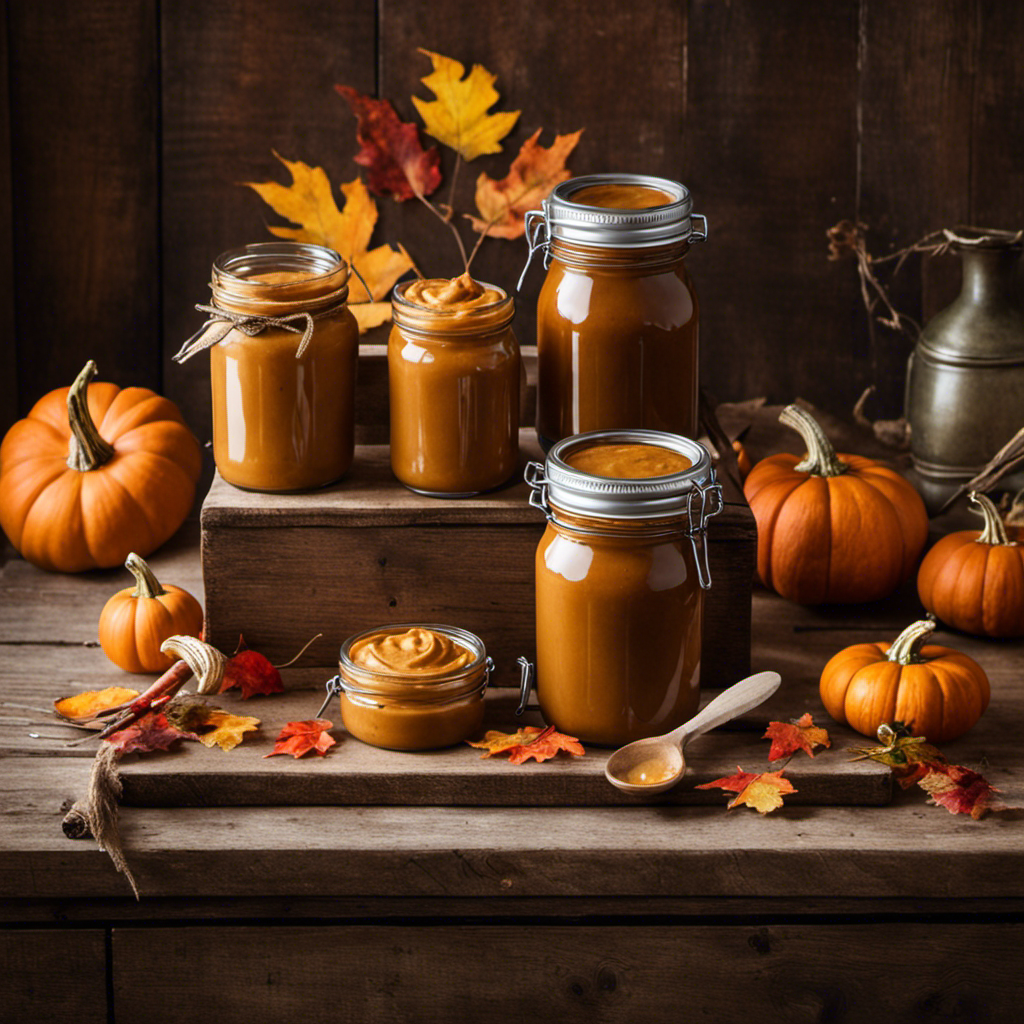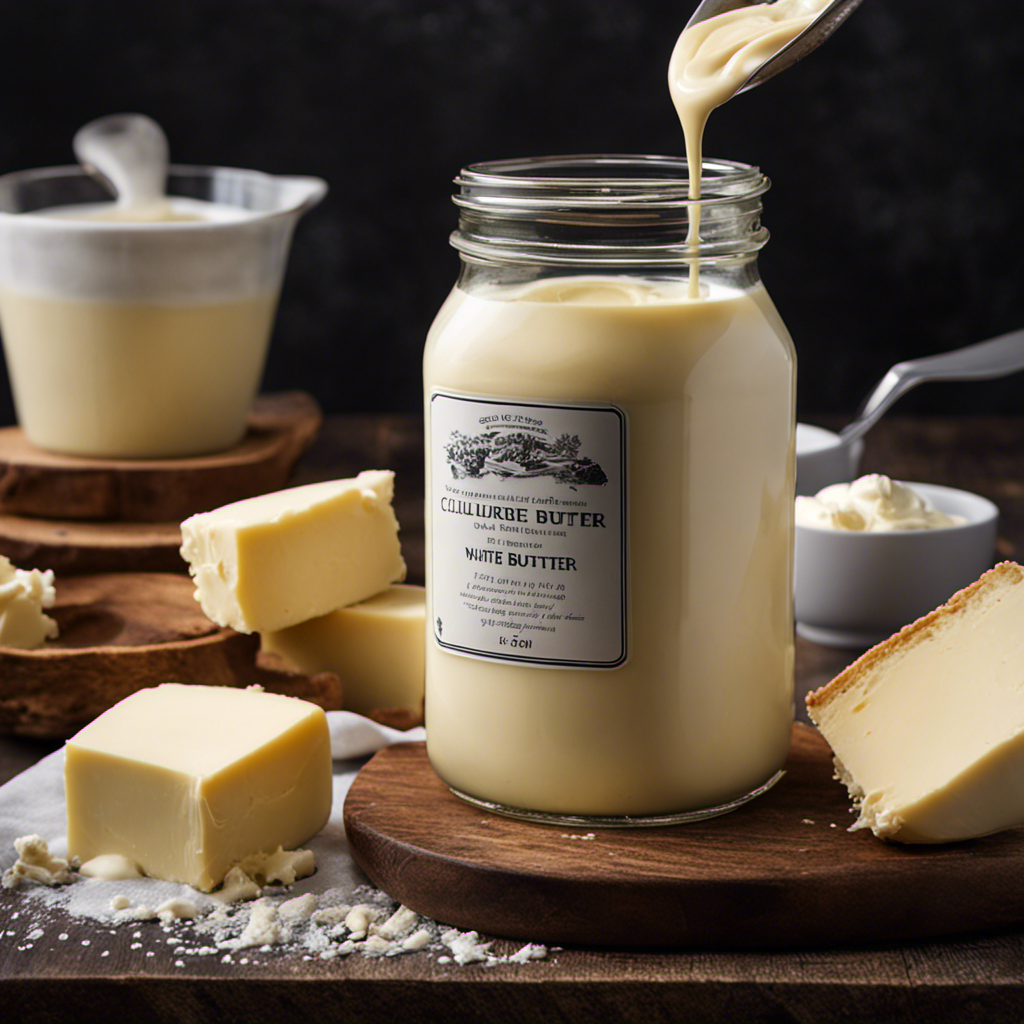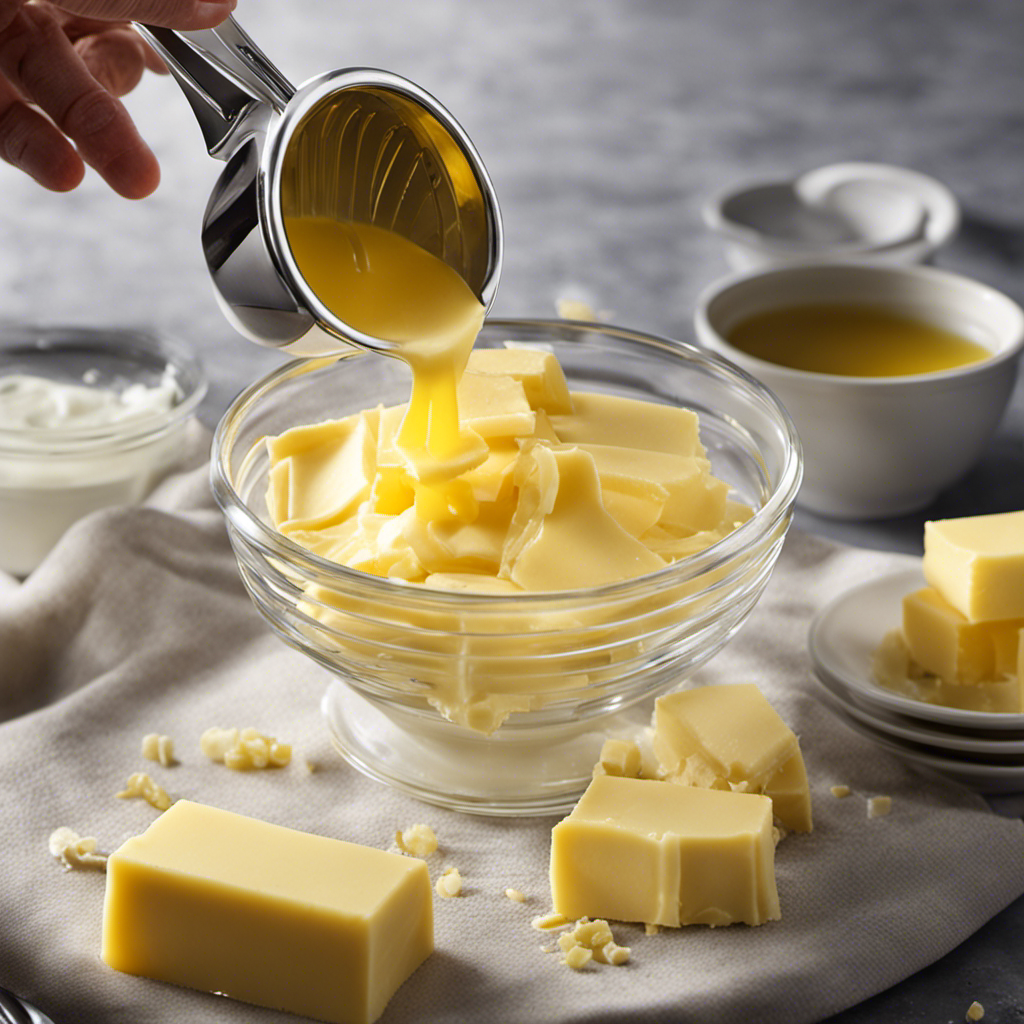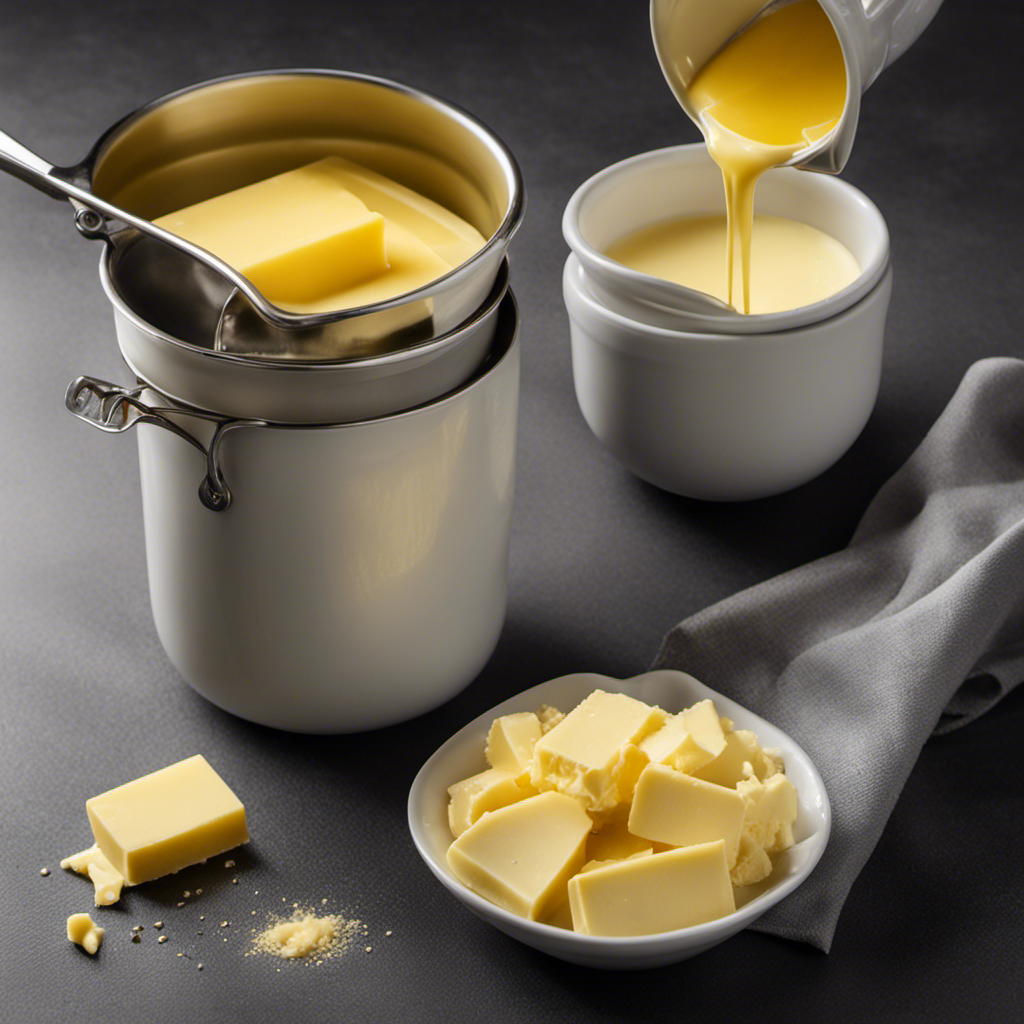In search of the perfect solution to your pumpkin desires? Wondering where to get the most delicious pumpkin butter? Your search ends here!
In this article, I’ll guide you through the top spots to find this delectable treat. From local farmers’ markets brimming with fresh, homemade options, to specialty grocery stores and online retailers offering a wide selection, there’s a pumpkin butter paradise waiting for you.
Get ready to indulge in the creamy, spiced goodness of this fall favorite. Let’s dive in!
Key Takeaways
- Local farmers’ markets offer a variety of fresh, homemade pumpkin butter options, ensuring high quality and freshness.
- Specialty grocery stores offer a range of pumpkin butter brands and flavors, including popular brands like Stonewall Kitchen, Trader Joe’s, and Williams Sonoma.
- Online shopping provides access to a wide variety of pumpkin butter options, with the ability to compare prices, read customer reviews, and find creative recipes.
- Health food stores offer a great selection of pumpkin butter, including options for different dietary preferences such as organic or all-natural varieties.
Local Farmers’ Markets
You can find local farmers’ markets near you that sell pumpkin butter. These markets are a treasure trove of fresh, locally sourced produce and homemade goodies. When it comes to pumpkin butter, these markets are your best bet for finding unique and delicious options.
Many of these markets work closely with local pumpkin farms, ensuring that you get the freshest and highest quality pumpkins for your homemade pumpkin recipes. The vendors at these markets take pride in their homemade pumpkin butter, using traditional recipes passed down through generations. They carefully cook and blend the pumpkin with spices like cinnamon and nutmeg, creating a rich and flavorful spread that is perfect for toast, pancakes, or even as a filling for pastries.
Specialty Grocery Stores
When it comes to finding pumpkin butter, two important factors to consider are local availability and prices.
Local availability refers to the accessibility of pumpkin butter in your area and can vary depending on where you live.
Prices, on the other hand, can also vary greatly depending on the brand and location.
Some popular pumpkin butter brands to look out for include Stonewall Kitchen, Trader Joe’s, and Williams Sonoma, all of which offer their own unique flavors and textures.
Local Availability and Prices
If you’re looking for local availability and prices for pumpkin butter, try checking out your nearest farmers market or specialty grocery store. These places often carry a variety of pumpkin butter brands and flavors, allowing you to choose the one that suits your taste preferences. In addition, they may also offer homemade pumpkin butter that is made from fresh, locally sourced ingredients. To give you an idea of the options available, here is a table showcasing some popular pumpkin butter brands and their prices at a local farmers market:
| Brand | Price (8 oz) | Price (16 oz) |
|---|---|---|
| Brand A | $5.99 | $9.99 |
| Brand B | $4.99 | $8.99 |
| Brand C | $6.99 | $11.99 |
| Brand D | $7.99 | $13.99 |
| Brand E | $5.49 | $10.49 |
Pumpkin butter is not only delicious, but it also offers several benefits. It is a good source of fiber, vitamin A, and antioxidants. It can be used as a spread on toast or bagels, as a topping for pancakes or waffles, or as an ingredient in various recipes such as pumpkin butter cookies or pumpkin butter swirl brownies. So, next time you’re in the mood for some pumpkin butter, head to your local farmers market or specialty grocery store and explore the options available to you.
Popular Pumpkin Butter Brands
Check out the table below for a list of popular brands and their prices at a local farmers market.
Pumpkin butter is a versatile and delicious spread that can be used in a variety of recipes. It adds a rich and creamy flavor to both sweet and savory dishes.
One popular brand is Grandma’s Pumpkin Butter, which is made with fresh pumpkin and a blend of spices. Another well-loved brand is Harvest Moon Pumpkin Butter, known for its smooth texture and natural sweetness.
Both brands offer jars of pumpkin butter at affordable prices, making it easy to incorporate this tasty spread into your cooking. From spreading on toast to using as a filling for pastries, the uses for pumpkin butter are endless.
Get creative and experiment with different pumpkin butter recipes to discover new and delicious ways to enjoy this seasonal treat.
Online Retailers
When it comes to online shopping, there are a few key points that I always consider:
-
The best online prices: Finding the best online prices is essential because it allows me to save money and get the most value for my purchase.
-
Customer reviews and ratings: I rely on customer reviews and ratings to help me make informed decisions, as they provide insights into the quality and performance of the product.
-
Shipping options and fees: Understanding the shipping options and fees is crucial to ensure that I receive my order in a timely manner and at a reasonable cost.
Best Online Prices
You can find the best online prices for pumpkin butter at various websites. Whether you’re looking for a classic pumpkin butter or a unique flavor combination, there are plenty of options available.
One great way to gauge the quality of a product is by reading customer testimonials. Many websites offer reviews from previous buyers, giving you insight into the taste and texture of the pumpkin butter.
Additionally, these websites often provide pumpkin butter recipes, allowing you to get creative in the kitchen and try new flavors.
By finding the best online prices and reading customer testimonials, you can make an informed decision about which pumpkin butter to purchase.
Now let’s take a closer look at customer reviews and ratings to further assist you in your decision-making process.
Customer Reviews and Ratings
After searching for the best online prices for pumpkin butter, I decided to dive deeper into customer reviews and ratings to ensure customer satisfaction and product quality.
As a consumer, I value the opinions of others who have already purchased and tried the product. Reading through the reviews, I found that many customers praised the smooth texture and rich flavor of the pumpkin butter. They mentioned how it enhanced their morning toast and added a delightful twist to their baking recipes.
The majority of the reviewers expressed their satisfaction with the overall product quality, highlighting its natural ingredients and long shelf life. Additionally, some reviewers even shared creative ways to incorporate pumpkin butter into their favorite dishes, inspiring me to experiment in my own kitchen.
Overall, the positive customer reviews and high ratings solidified my decision to purchase pumpkin butter online.
Shipping Options and Fees
To avoid any surprises, check the available shipping options and fees before making your final decision. When it comes to shipping options, it’s important to consider both the speed of delivery and the cost. Here are two things to keep in mind:
-
Delivery Times:
-
Standard shipping: Typically takes 5-7 business days.
-
Expedited shipping: Arrives within 2-3 business days, but at a higher cost.
-
Fees:
-
Standard shipping: Usually comes with a flat fee of $5.
-
Expedited shipping: Can cost up to $15, depending on the weight and size of the package.
Considering these factors will help you make an informed decision about which shipping option is best for you.
Now, let’s move on to the next section, where we’ll explore health food stores and their offerings.
Health Food Stores
There’s a great selection of health food stores that carry pumpkin butter. These stores not only provide a wide variety of pumpkin butter options, but they also offer other healthy and organic products.
One such store is Green Grocers, located in the heart of downtown. They pride themselves on sourcing local produce and supporting local farmers. At Green Grocers, you can find pumpkin butter made from locally grown pumpkins, ensuring freshness and quality.
Another great option is Nature’s Pantry, a popular health food store known for its organic options. They carry a range of pumpkin butter brands, all made with organic ingredients.
Shopping at health food stores not only allows you to indulge in delicious pumpkin butter but also supports local farmers and promotes a healthier lifestyle.
Gourmet Food Shops
You’ll find a wide selection of gourmet food shops in the area. These shops are a food lover’s paradise, offering an array of delicious and high-quality products.
Here are some reasons why these gourmet food shops are worth exploring:
- They source their ingredients from local pumpkin farms, ensuring freshness and supporting the local community.
- The pumpkin butter recipes available in these shops are simply divine. The creamy texture and rich flavor of the pumpkin butter make it the perfect accompaniment to toast, pancakes, or even as a filling for pastries.
- Some shops even offer unique variations of pumpkin butter, such as spiced pumpkin butter with a hint of nutmeg or maple pumpkin butter with a touch of sweetness.
Indulging in gourmet food from these shops will not only satisfy your taste buds but also support local farmers and artisans. So, why not treat yourself to a jar of delectable pumpkin butter from a gourmet food shop today?
Homemade Pumpkin Butter Suppliers
One of the best things about homemade pumpkin butter suppliers is the variety of delicious flavors they offer. When it comes to homemade pumpkin butter recipes, the possibilities are endless.
From classic pumpkin spice to unique combinations like pumpkin pecan or pumpkin maple, there is a flavor for every taste bud.
The benefits of pumpkin butter go beyond its incredible taste. It is packed with nutrients like vitamin A, potassium, and fiber. Pumpkin butter is also low in calories and fat, making it a healthier alternative to traditional butter or spreads.
Not only does it add a burst of flavor to toast, pancakes, or oatmeal, but it also provides a boost of nutrition. Whether you’re looking for a sweet or savory option, homemade pumpkin butter suppliers have something for everyone.
Frequently Asked Questions
What Are Some Popular Recipes or Uses for Pumpkin Butter?
Pumpkin butter recipes are versatile and delicious. I love using it as a spread on toast or pancakes, swirling it into oatmeal, or adding it to baked goods like muffins or cookies. The possibilities are endless!
Can I Find Organic or All-Natural Pumpkin Butter at Any of These Locations?
Sure, you can find organic or all-natural pumpkin butter at some locations. Organic pumpkin butter is made from organically grown pumpkins, while conventional pumpkin butter may have synthetic additives. All-natural pumpkin butter offers the benefits of pure ingredients.
Are There Any Seasonal or Limited-Time Flavors of Pumpkin Butter Available?
Yes, there are seasonal pumpkin butter flavors available. Some popular options include cinnamon spice, maple pecan, and gingerbread. The best places to buy pumpkin butter online are specialty food stores, farmer’s markets, and online retailers.
Do Any of These Locations Offer Pumpkin Butter Made From Local or Regional Pumpkins?
When it comes to pumpkin butter, I have done my research to find the best options. Local pumpkin farms are the key to finding pumpkin butter made from fresh, regional pumpkins.
Are There Any Discounts or Promotions Available for Purchasing Pumpkin Butter at These Locations?
There are a few discounts and promotions available for purchasing pumpkin butter at different locations. Prices vary, so it’s worth comparing prices to get the best deal.
Conclusion
In conclusion, finding pumpkin butter is a delightful journey that takes you through bustling farmers’ markets, charming specialty grocery stores, and convenient online retailers.
The vibrant colors and intoxicating aroma of this fall treat are sure to transport you to a cozy pumpkin patch.
Whether you prefer to support local farmers or explore the vast selection of gourmet food shops, there is a perfect pumpkin butter waiting for you.
So, embark on this culinary adventure and indulge in the velvety smoothness of homemade pumpkin butter, a true autumn treasure.









